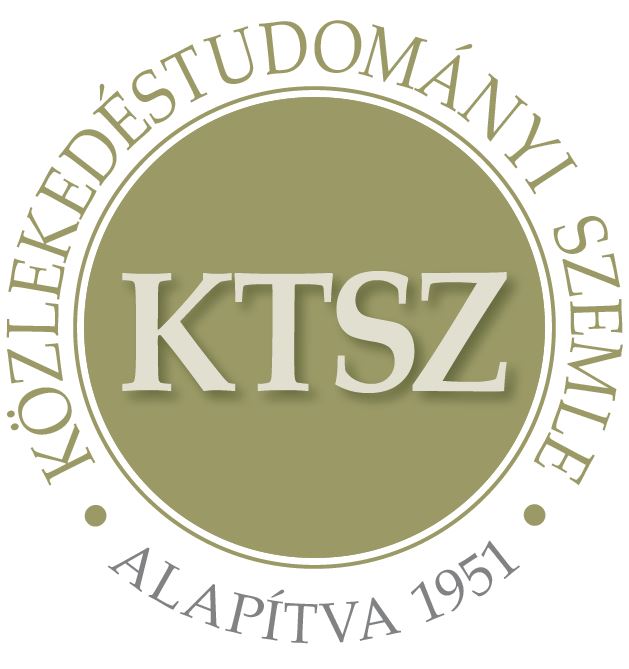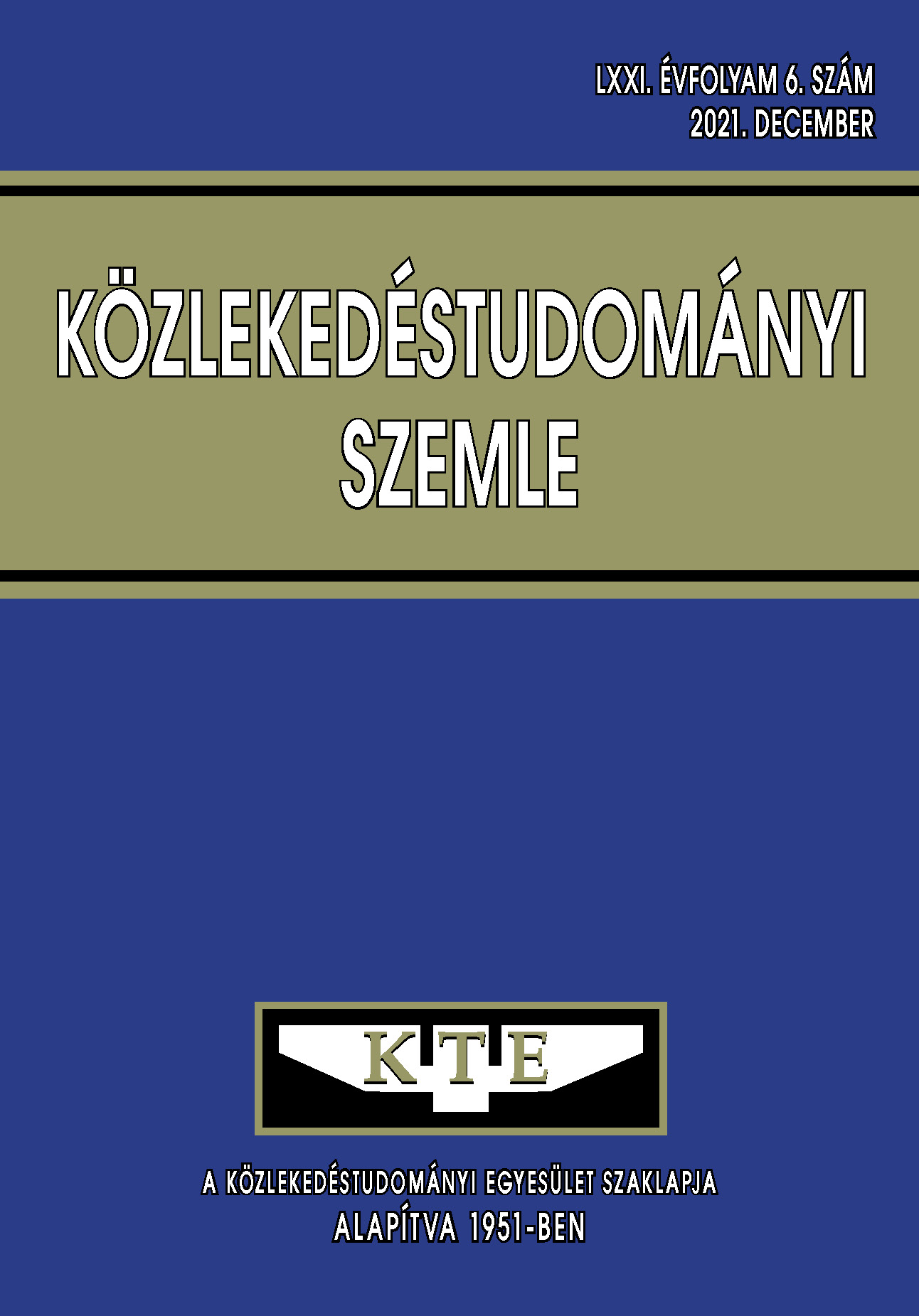Determining the weighting factor of public transport modes in urban environments – a possible methodology
Abstract
The authors examine whether it is possible to carry out transport development, and through it economic development, as a result of which emissions are reduced at the system level. his requires a comparison of existing public transport networks by mode, which is very difficult, however, as the appropriate ratios are not available. During the research, a linearized regression model was constructed, which was based on the examination of 421 cities. The model provides information on the role of each mode of transport and, through this, to the considerations to be taken into account in the development of the transport networks.
References
Európai Bizottság, ‘Fehér Könyv – Útiterv az egységes európai közlekedési térség megvalósításához – Úton egy versenyképes és erőforrás-hatékony közlekedési rendszer felé’, Európai Bizottság, Brüsszel, COM/2011/0144, Mar. 2011. Accessed: May 30, 2021. [Online]. Available: https://eurlex.europa.eu/legal-content/HU/TXT/PDF/?uri=CELEX:52011DC0144&qid=1622382850857&from=HU
Szabó Z. and Török Á., ‘Tranzitforgalmak Magyarországon: Egy térökonometriai elemzés’, Közlekedéstudományi Konferencia, vol. 8, pp. 201–212, 2018.
Szalmáné Csete M., ‘Smart city koncepciók a fenntartható városfejlesztésben’, presented at the Okos városok és területi statisztika, Budapest, Feb. 27, 2019. Accessed: Oct. 15, 2019. [Online]. Available: https://www.ksh.hu/okosvarosok_2019_02_27
Dusek T., ‘Az okos városok komplex mutatószámai’, presented at the Okos városok és területi statisztika, Budapest, Feb. 27, 2019. Accessed: Oct. 15, 2019. [Online]. Available: https://www.ksh.hu/okosvarosok_2019_02_27
Z. Szabó, Á. Török, and T. Sipos, ‘Order of the Cities: Usage as a Transportation Economic Parameter’, Period. Polytech. Transp. Eng., vol. 49, no. 2, pp. 164–169, 2021, DOI: https://doi.org/gt43
Lénár G., Az eltékozolt kisvasút, 2nd ed. Sátoraljaújhely: dr. Lénár György, 2015.
J. Friedmann, ‘The Wealth of Cities: Towards an Assets-based Development of Newly Urbanizing Regions: The Wealth of Cities’, Development and Change, vol. 38, no. 6, pp. 987–998, Nov. 2007, DOI: https://doi.org/dbd7hw
J. V. Beaverstock, R. G. Smith, and P. J. Taylor, ‘A roster of world cities’, Cities, vol. 16, no. 6, pp. 445–458, Dec. 1999, DOI: https://doi.org/c32fvx
P. J. Taylor and M. Hoyler, ‘The spatial order of European cities under conditions of contemporary globalisation’, Tijdschrift voor Economische en Sociale Geografie, vol. 91, no. 2, pp. 176–189, 2000, DOI: https://doi.org/bctg9h
T. Herrschel and P. Newman, Governance of Europe’s city regions: planning, policy & politics. Routledge, 2003.
M. Fellesson and M. Friman, ‘Perceived Satisfaction with Public Transport Service in Nine European Cities’, J Transp Res Forum, vol. 47, no. 3, Feb. 2012, DOI: https://doi.org/f23gfb
T. Klinger, J. R. Kenworthy, and M. Lanzendorf, ‘Dimensions of urban mobility cultures – a comparison of German cities’, Journal of Transport Geography, vol. 31, pp. 18–29, Jul. 2013, DOI: https://doi.org/f5c363
J. Pucher and S. Kurth, ‘Verkehrsverbund: the success of regional public transport in Germany, Austria and Switzerland’, Transport Policy, vol. 2, no. 4, pp. 279–291, Oct. 1995, DOI: https://doi.org/bnkmrz
J. Sienkiewicz and J. A. Hołyst, ‘Statistical analysis of 22 public transport networks in Poland’, Phys. Rev. E, vol. 72, no. 4, p. 046127, Oct. 2005, DOI: https://doi.org/b43qnm
O. Cats, ‘Topological evolution of a metropolitan rail transport network: The case of Stockholm’, Journal of Transport Geography, vol. 62, pp. 172–183, Jun. 2017, DOI: https://doi.org/gb2vm8
J. Preston, ‘Public transport demand’, in Handbook of Research Methods and Applications in Transport Economics and Policy, C. Nash, Ed. Cheltenham, UK: Edward Elgar Publishing, 2015, pp. 192–211. DOI: https://doi.org/gt44
J. Scheurer and S. Porta, ‘Centrality and connectivity in public transport networks and their significance for transport sustainability in cities’, presented at the World Planning Schools Congress, Mexico DF, Jul. 13, 2006.
J.-E. Nilsson, ‘Congestion and scarcity in scheduled transport modes’, in Handbook of Research Methods and Applications in Transport Economics and Policy, Cheltenham, UK: Edward Elgar Publishing, 2015, pp. 134–153.
A. T. Murray, R. Davis, R. J. Stimson, and L. Ferreira, ‘Public Transportation Access’, Transportation Research Part D: Transport and Environment, vol. 3, no. 5, pp. 319–328, Sep. 1998, DOI: https://doi.org/bbtmzx
A. A. Schmalz and Á. Török, ‘Transportation in Brazil: Joinville’, Periodica PolytechnicaTransportation Engineering, vol. 46, no. 2, pp. 78–81, 2018, DOI: https://doi.org/gt45
M. A. Saif, M. M. Zefreh, and A. Torok, ‘Public Transport Accessibility: A Literature Review’, Periodica Polytechnica Transportation Engineering, vol. 47, no. 1, pp. 36–43, 2019, DOI: https://doi.org/gt46
G. Gaal, E. Horváth, Á. Török, and M. Csete, ‘Analysis of Public Transport Performance in Budapest, Hungary’, Periodica Polytechnica Social and Management Sciences, vol. 23, no. 1, pp. 68–72, 2015, DOI: https://doi.org/gt47
V. Pina and L. Torres, ‘Analysis of the efficiency of local government services delivery. An application to urban public transport’, Transportation Research Part A: Policy and Practice, vol. 35, pp. 929–944, 2001, DOI: https://doi.org/cmjcs2
A. T. Murray, ‘Strategic analysis of public transport coverage’, Socio-Economic Planning Sciences, vol. 35, no. 3, pp. 175–188, Sep. 2001, DOI: https://doi.org/cjfxv9
K. S. Kim, L. Benguigui, and M. Marinov, ‘The fractal structure of Seoul’s public transportation system’, Cities, vol. 20, no. 1, pp. 31–39, Feb. 2003, DOI: https://doi.org/fdphq4
J. Zhang, J. Li, and Y. Wu, ‘A Study of Metro Organization Based on Multiobjective Programming and Hybrid
Genetic Algorithm’, Periodica Polytechnica Transportation Engineering, vol. 45, no. 4, p. 223, Aug. 2017, DOI: https://doi.org/gt48
M. N. Borhan, A. N. H. Ibrahim, D. Syamsunur, and R. A. Rahmat, ‘Why Public Bus is a Less Attractive Mode of Transport: A Case Study of Putrajaya, Malaysia’, Period. Polytech. Transp. Eng., vol. 47, no. 1, pp. 82–90, 2019, DOI: https://doi.org/gt49
F. Gumz and Á. Török, ‘Investigation of Cordon Pricing in Budakeszi’, Periodica Polytechnica Transportation Engineering, vol. 43, no. 2, pp. 92–97, 2015, DOI: https://doi.org/gt5b
I. Y. (Jackiva), E. B. (Budiloviča), and V. Gromule, ‘Accessibility to Riga Public Transport Services for Transit Passengers’, Procedia Engineering, vol. 187, pp. 82–88, 2017, DOI: https://doi.org/gt5c
D. Šipuš and B. Abramović, ‘The Possibility of Using Public Transport In Rural Area’, Procedia Engineering, vol. 192, pp. 788–793, 2017, DOI: https://doi.org/gt5d
I. Dadić, G. Štefančić, and M. Rajsman, ‘Zagrebačka County and the City of Zagreb as the Centre of the Croatian Transport System’, Promet-Traffic-Traffico, vol. 13, no. S4, pp. 17–24, 2001.
M. Matulin, Š. Mrvelj, and N. Jelušić, ‘Evaluating Public Transport Performances by Utilizing Probe Vehicles’, International Journal for Traffic and Transport Engineering, vol. 4, no. 2, pp. 183–193, 2014. DOI: https://doi.org/gt5f
Szabó Z. and Sipos T., ‘Ingázás a nagyvárosba – Egy országos igénymodell felállítása’, Területi Statisztika, vol. 60, no. 5, pp. 581–605, 2020, doi: https://doi.org/10.15196/TS600504.
Vásárhelyi B. and Szabó D., Eds., Városi közlekedési kézikönyv. Budapest: Műszaki Kiadó, 1965.
L. Á. Molnár, ‘Arányok, egyensúlyok, értékek a közlekedésben avagy miként lehet rengő föld idején házat építeni?’, presented at the XIX. Városi közlekedés aktuális kérdései, Visegrád, 0 12, 2019.
M. Börjesson, R. D. Jonsson, and M. Lundberg, ‘An ex-post CBA for the Stockholm Metro’, Transportation Research Part A: Policy and Practice, vol. 70, pp. 135–148, Dec. 2014, DOI: https://doi.org/f3nxx3
B. Caulfield, D. Bailey, and S. Mullarkey, ‘Using data envelopment analysis as a public transport project appraisal tool’, Transport Policy, vol. 29, pp. 74–85, 2013, DOI: https://doi.org/f5c36g
P. Hodgson, S. Potter, J. Warren, and D. Gillingwater, ‘Can bus really be the new tram?’, Research in Transportation Economics, vol. 39, pp. 158–166, 2013, DOI: https://doi.org/gt5g
Carris, ‘Relatório e Contas 2018 (Reports and Accounts)’, Companhia Carris de Ferro de Lisboa, E.M., S.A., Lisszabon, 2018. [Online]. Available: http://www.carris.pt/fotos/editor2/carris_relatorio_e_contas_3.pdf
G. S. Maddala, Introduction to Econometrics, 3rd ed. Chichester, UK: John Wiley&Sons Ltd, 2001.
Bolla M. and Krámli A., Statisztikai következtetések elmélete, 2nd ed. Budapest: TYPOTEX Kiadó, 2005.
Copyright (c) 2021 Scientific Review of Transport

This work is licensed under a Creative Commons Attribution-NonCommercial-ShareAlike 4.0 International License.
Articles published electronically are open access (OJS), freely available online and can be downloaded. Authors of articles are not charged any publication or publishing costs (APC). Users have the right to read, download, copy, print, and search the articles, or share the full text with a link.
Authors must declare that their submission has not been previously published in another journal, that financial support has been acknowledged, and that the list of references is complete and accurate, including specification of URLs and DOIs (if available). When submitting a draft article, each author approves the submitted version. Authors guarantee that the article is their original work. Authors are required to participate in the peer review process, follow the advice of reviewers, meet the prescribed deadlines, and, if any, withdraw the submission or correct errors.
All submitted articles are subject to peer review, where the editors request an independent evaluation from at least one expert, ensuring that the reviewer(s) have no conflicts of interest with the authors. The final decision is made by the Editor-in-Chief, who takes into account the evaluations and the suggestions of the editors. The editors and reviewers treat the submission confidentially.
The publisher and editors are committed to maintaining high ethical standards and to preventing publications that involve research misconduct. They follow the COPE guidelines on such ethical issues.
The authors retain copyright and grant the journal the right of first publication under the Creative Commons License (https://creativecommons.org/licenses/by-nc-nd/4.0), which allows others to share the work, while acknowledging the authorship of the work and the first publication in the journal.
The journal archives all published articles, and the journal's owner, the Hungarian Society of Transportation Sciences, will continue to operate the database even if the journal ceases to be published.















